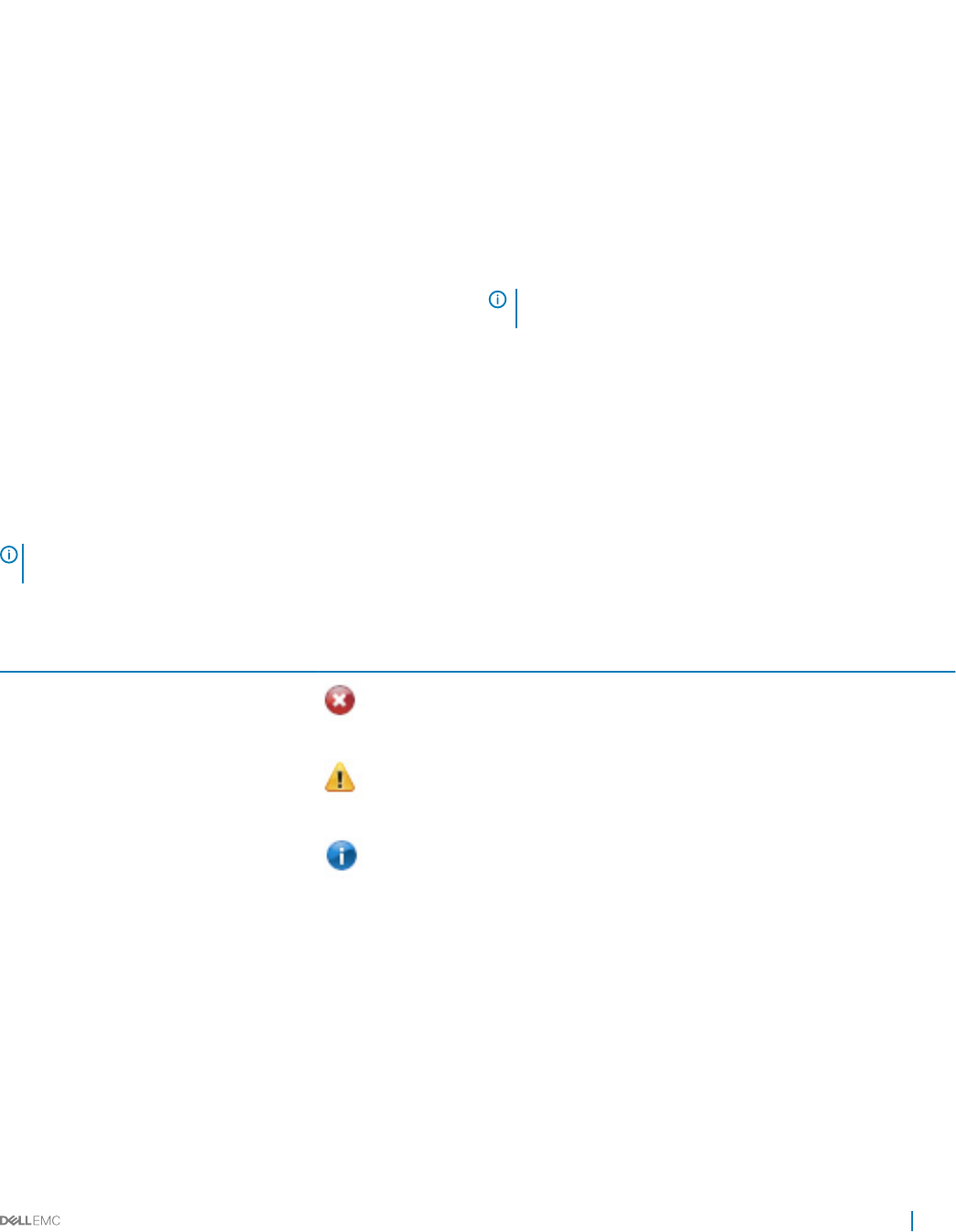Users Guide
Table Of Contents
- Dell EMC OpenManage Power Center 4.0 User’s Guide
- Overview
- Getting started
- Using OpenManage Power Center
- Preinstallation requirement for OpenManage Power Center
- Using Power Center on Microsoft Windows operating systems
- Installing OpenManage Power Center on Microsoft Windows Server
- Installed directories in Windows
- OpenManage Power Center services on Microsoft Windows operating systems
- Upgrading Power Center on Microsoft Windows operating systems
- Uninstalling OpenManage Power Center on Microsoft Windows operating system
- Launching OpenManage Power Center on Microsoft Windows operating systems
- Configuring Enhanced Security Configuration for Internet Explorer
- Using OpenManage Power Center on Linux operating systems
- Using OpenManage Power Center through Command Line Interface
- Command Line Interface error handling
- Command Line Interface commands
- help
- add_profile
- update_profile
- add_device
- update_device
- rediscover_device
- find_device
- remove_profile
- delete_device
- add_group
- delete_group
- update_group
- add_device_to_group
- remove_device_from_group
- move_device
- move_group
- add_group_to_group
- List commands
- list_device_props
- list_devices
- list_group_props
- list_groups
- list_report_groups
- list_reports
- run_report
- discover_device
- backup_database
- restore_database
- add_ssh_server_key
- remove_ssh_server_key
- list_ssh_server_key
- Command line interface error codes
- Access control
- Task management
- Device Management
- Virtual machines
- Power Monitoring
- Temperature Monitoring
- Policies
- Analysis
- Managing reports
- Event Management
- Security
- Configuring settings
- Logs
- Troubleshooting
- Why am I being required to log in more than once by Power Center?
- Why can’t I access the Power Center management console from a Web browser, even though the Power Center server is running normally?
- Why was I automatically logged out of Power Center?
- Why did my connection to iDRAC6 devices (PowerEdge Servers) fail, when the network connection status is Connected?
- Why can’t Power Center receive events sent from devices?
- Why are previously-existing power policies (including EPR) still effective on devices when Power Center is corrupted or has been uninstalled?
- Why do I see the PostgreSQL error log "FATAL: terminating connection due to administrator command" in the Windows event log?
- Why I can’t open power center login page when I access it through Firefox 31?
- Why I encounter an error, “An internal error occurred. Contact the technical support for help: subordinate error code: 0x8f0c1301”, the Home page when OpenManage Power Center server is installed on SUSE Linux Enterprise Server 11 SP2?
- Why do I encounter a network exception while adding a LDAP user?
- Why do I encounter a network exception while adding a chassis to a group?
- In the compare report, why is the average power value of a device different when the service is stopped for a few hours?
- Why is the “policy return to normal” event not displayed when the only device in the Chassis Management Controller (CMC) is deleted?
- After discovering the devices, incorrect device information is displayed? Why is this happening?
- I am not able to view the power headroom graph on the home screen. How do I troubleshoot?
- I am not able to manage the servers discovered by OMPC through the Redfish protocol. Events are also not logged. How do I troubleshoot and resolve the issue?
- I discovered a server through the Redfish protocol. When I tried to manage the server, the events are not logged in the event list. What do I do now?
- Upgrade failure recovery on Microsoft Windows operating system
- Upgrade failure recovery on Linux operating system

Table 11. PDU and UPS events
PDU/UPS Model Supported Events
Dell UPS UPS Low Battery, UPS Bad Input
APC UPS UPS Low Battery, UPS Shutdown, UPS On Bypass
Eaton UPS UPS Low Battery, UPS Bad Input, UPS Bad Battery
Emerson UPS UPS Low Battery
Dell PDU PDU Low Load, PDU High Load, PDU Overload, PDU Outlet Low
Load*, PDU Outlet High Load*, PDU Outlet Overload*, PDU Outlet
On*, PDU Outlet O*
NOTE: Events marked with * are only supported on Dell
Managed Rack PDU 6605.
APC PDU PDU Low Load, PDU High Load, PDU Overload
ServerTech PDU PDU High Load, PDU Outlet On, PDU_Outlet O
Emerson PDU PDU Low Load, PDU High Load, PDU Overload
Event severity levels
NOTE
: Severity levels dened in Power Center may be inconsistent with the levels dened on monitored devices. For example,
an event dened as severe on a device might be considered a warning event in Power Center.
Table 12. Power Center event severity levels
Severity Level Icon Description
Critical Errors that cause managed devices or
Power Center to stop working properly. You
must take action to resolve the issue.
Warning Errors requiring attention. You should look
into the root cause to determine whether to
take action.
Informative Event that is not an error or warning. This is
an informational event; you do not need to
take action.
Viewing events
The number of events is displayed at the top-right corner on the OpenManage Power Center screen.
There are several ways to view Power Center events:
• Using the left pane: — In the left pane, click Events.
• Using the Critical Event Notication icon:
a Click the Critical Event Notication icon in the upper right corner of the OpenManage Power Center screen.
Event Management
107










